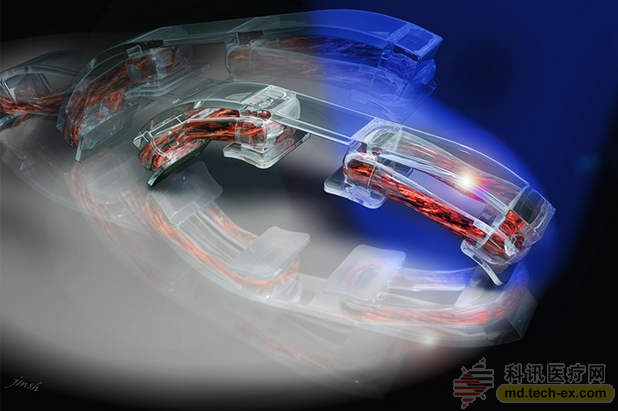Release date: 2016-03-18
Recently, scientists from the University of Illinois at Urbana-Champaign have developed a bio-bots composed of living muscle cells and 3D printing frames. The point is that it can see (or sense light) – and move toward the place where the light shines.
According to the scientists, when a light-controlled ring-shaped muscle actuator that responds to light stimuli and produces a force of up to 0.56 kPa is incorporated into the frame of a 3D printed biological machine skeleton, it can drive the latter directionality. Motion and rotary steering provide a model for future development of dynamic biological machines that respond to environmental signals in real time. 
The study was led by Rashid Bashir, head of bioengineering at the University of Illinois, and the results have been published in the recently published Proceedings of the National Academy of Sciences.
“Light controls these machines in a non-intrusive way,†Bashir said. “This gives us flexibility in the design and movement of the robot. The minimum goal we have to achieve is the forward design of the biological system. We believe that light control is an important step towards achieving this goal."
Prior to this, Bashir's team had demonstrated that the robot could be activated by an electric field, but Bashir said that electricity would have adverse side effects on the biological environment and that the robot could not be controlled by selective stimulation of different areas of the muscle. And this new light stimulation technology causes less damage, and researchers can control the biological robot to move in different directions. The biorobot will turn and head toward the direction of light stimulation, Bashir said.
The researchers first developed a muscle ring based on the mouse muscle cell line. This muscle cell was added with a gene that caused blue light of a certain wavelength to stimulate muscle contraction. This is called optogenetics. technology. The muscle ring is wound around a 3D printed flexible frame that varies in length from 7 mm to 2 cm.
“These skeletal muscle rings have been made into circular or rubber band-like shapes by our engineers because we want them to be modular,†said Ritu Raman, the lead author and graduate student of the paper. “This means we can use them as building blocks and combine them with 3D printed skeletons to create biobots for a variety of applications.â€
In addition to the modular design, the thin muscle ring allows light and nutrients to spread easily into all aspects of the tissue. This is the opposite of the design of early biorobots, where thick strips of muscle tissue are often used to grow around the bones.
Researchers have tried various sizes and shapes to find the most suitable configuration for the movement. In addition, they exercise muscle rings every day, using the flash to trigger muscles and make them stronger so that each time they contract, the robot moves further.
“This is a very flexible design,†Bashir said. “With these (muscle) rings, we can connect any two joints or hinges on the 3D printed skeleton. We can have multiple legs and multiple rings. Using light, We can control the direction in which they move. People can now use it to build more advanced robot systems." 
According to Tiangong, the study is actually part of the Emergent Behaviors of Integrated Cellular Systems project, funded by the National Science Foundation (NSF). In the fall of 2015, the EBICS program received an NSF total of $25 million for five years of research funding, enabling Bashir and his colleagues to continue to develop applications for biorobot technology in diagnostics, medicine, and remote sensing. .
Source: Tiangongshe
Fruits And Vegetables,Fresh Fruits And Vegetables,Fresh Fruit And Veggies,Fresh Vegetables
Xi'an Gawen Biotechnology Co., Ltd , https://www.seoagolyn.com